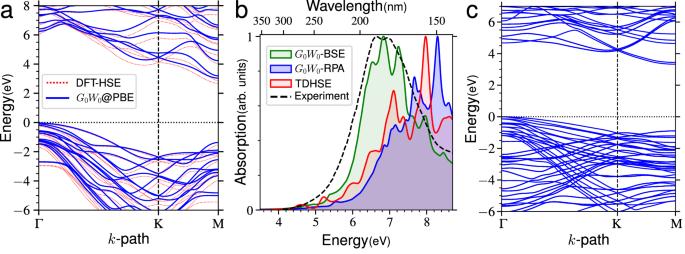Optoelectronic properties of electron-acceptor molecules adsorbed on graphene/silicon carbide interfaces
IF 7.5
Q1 MATERIALS SCIENCE, MULTIDISCIPLINARY
引用次数: 0
Abstract
Silicon carbide has emerged as an optimal semiconducting support for graphene growth. In previous studies, the formation of an interfacial graphene-like buffer layer covalently bonded to silicon carbide has been observed, revealing electronic properties distinct from ideal graphene. Despite extensive experimental efforts dedicated to this interface, theoretical investigations have been confined to its ground state. Here, we use many-body perturbation theory to study the electronic and optical characteristics of this interface and demonstrate its potential for optoelectronics. By adsorbing graphene, we show that the quasiparticle band structure exhibits a reduced bandgap, associated with an optical onset in the visible energy window. Furthermore, we reveal that the absorption of two prototypical electron-accepting molecules on this substrate results in a significant renormalization of the adsorbate gap, giving rise to distinct low-lying optically excited states in the near-infrared region. These states are well-separated from the substrate’s absorption bands, ensuring wavelength selectivity for molecular optoelectronic applications. The electronic features of graphene/silicon carbide have been well studied experimentally but theoretical investigations are still preliminary. Here, many-body perturbation theory reveals the electronic and optical characteristics of this interface and shows its advantages for optoelectronics.

吸附在石墨烯/碳化硅界面上的电子受体分子的光电特性
碳化硅已成为石墨烯生长的最佳半导体支持物。在之前的研究中,已经观察到与碳化硅共价键结合的类似石墨烯的界面缓冲层的形成,揭示了不同于理想石墨烯的电子特性。尽管针对该界面进行了大量实验,但理论研究一直局限于其基态。在这里,我们使用多体扰动理论来研究这一界面的电子和光学特性,并证明其在光电子学方面的潜力。通过吸附石墨烯,我们发现准粒子带结构呈现出带隙减小的现象,这与可见光能窗口中的光学起始点有关。此外,我们还揭示了在这种基底上吸收两种典型的电子接受分子会导致吸附剂间隙的显著重规范化,从而在近红外区域产生独特的低洼光激发态。这些态与基底的吸收带完全分离,确保了分子光电应用的波长选择性。石墨烯/碳化硅的电子特性已得到深入的实验研究,但理论研究仍处于初步阶段。在此,多体扰动理论揭示了这一界面的电子和光学特性,并显示了其在光电子学方面的优势。
本文章由计算机程序翻译,如有差异,请以英文原文为准。
求助全文
约1分钟内获得全文
求助全文
来源期刊

Communications Materials
MATERIALS SCIENCE, MULTIDISCIPLINARY-
CiteScore
12.10
自引率
1.30%
发文量
85
审稿时长
17 weeks
期刊介绍:
Communications Materials, a selective open access journal within Nature Portfolio, is dedicated to publishing top-tier research, reviews, and commentary across all facets of materials science. The journal showcases significant advancements in specialized research areas, encompassing both fundamental and applied studies. Serving as an open access option for materials sciences, Communications Materials applies less stringent criteria for impact and significance compared to Nature-branded journals, including Nature Communications.
文献相关原料
| 公司名称 | 产品信息 | 采购帮参考价格 |
|---|
 求助内容:
求助内容: 应助结果提醒方式:
应助结果提醒方式:


